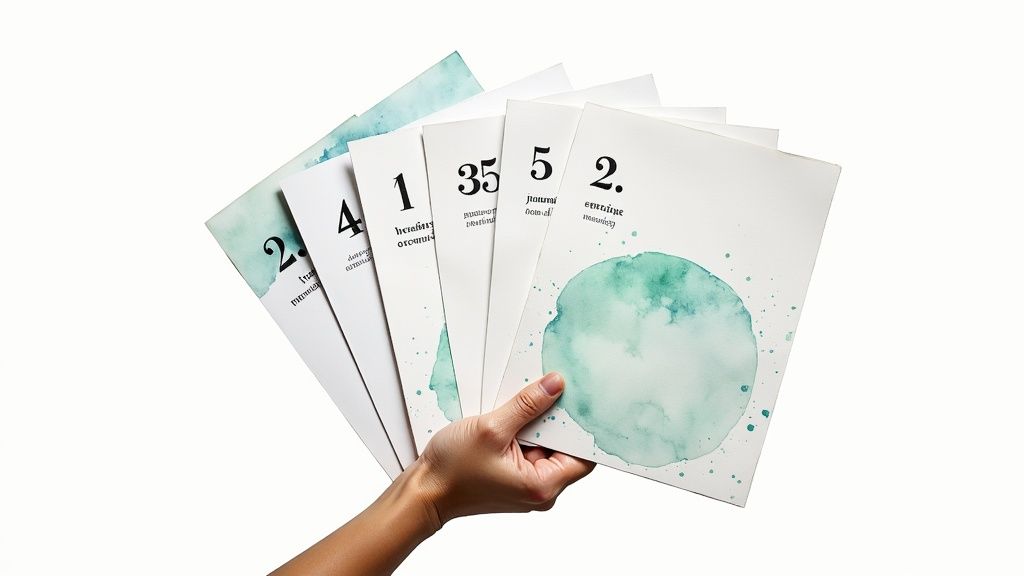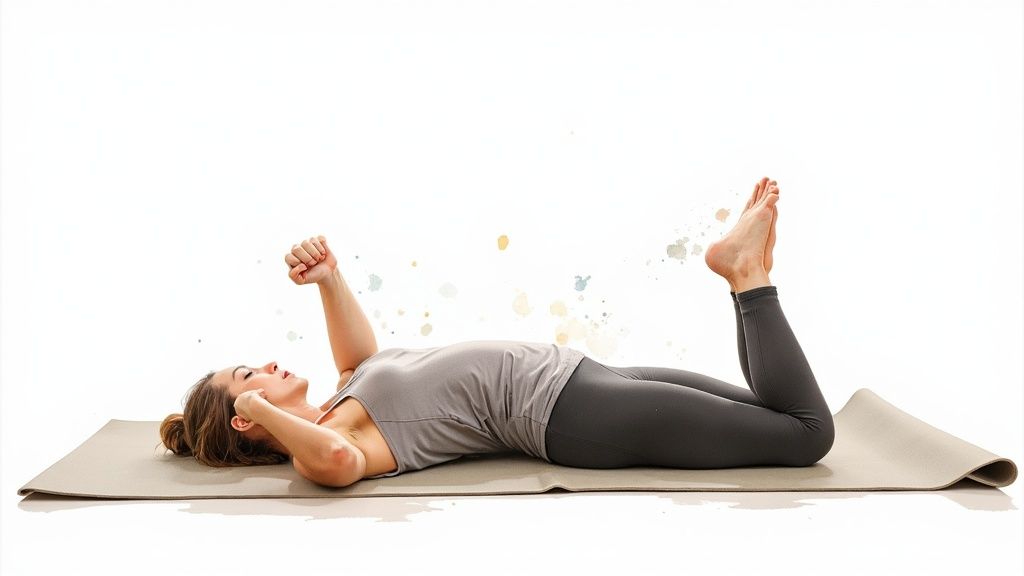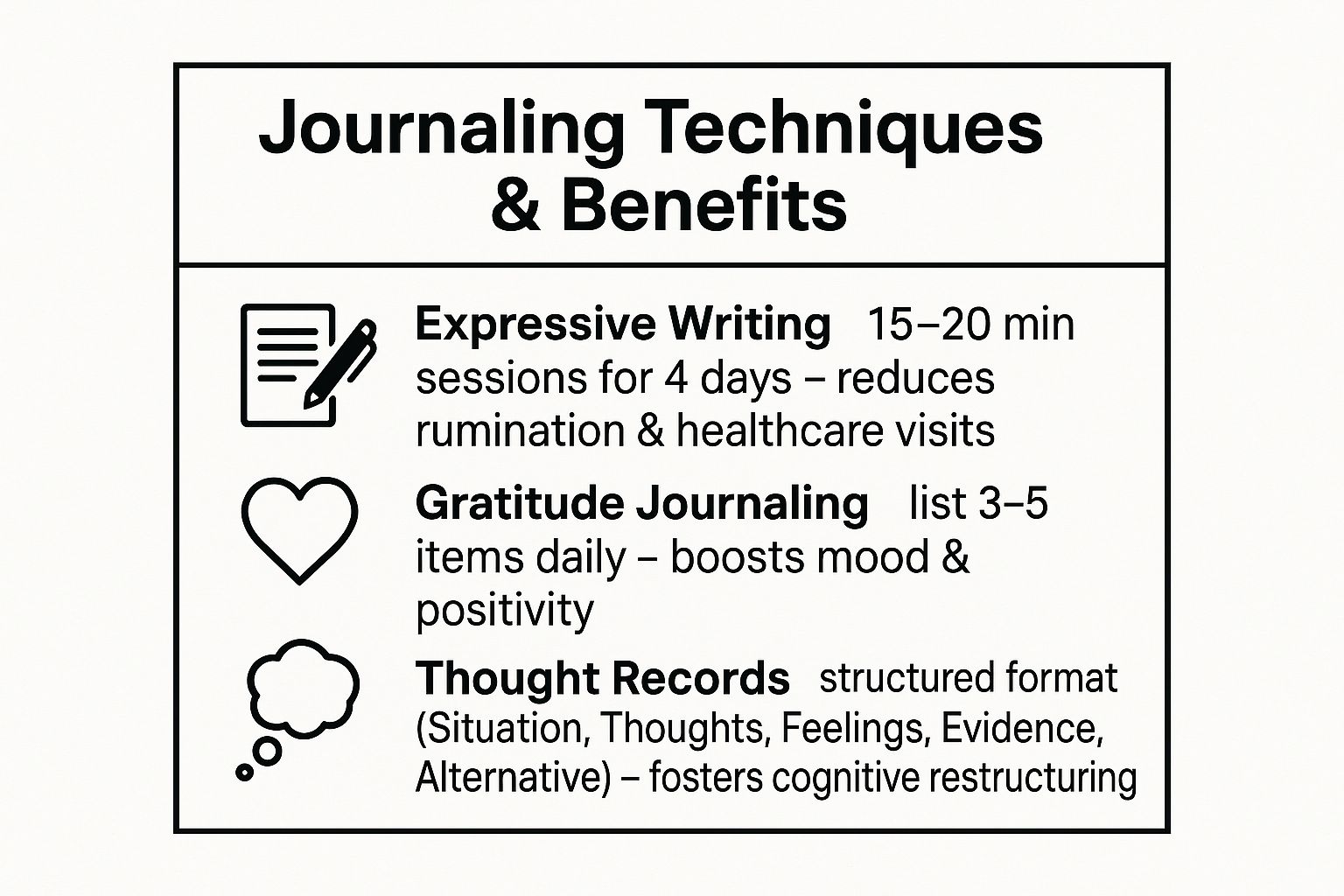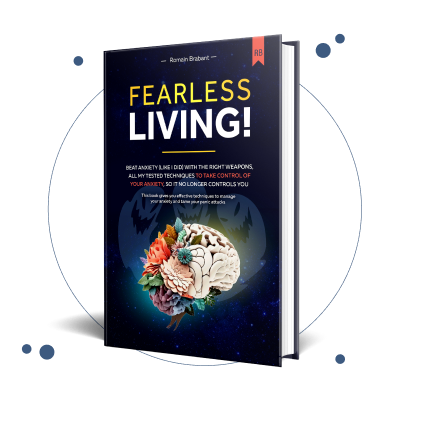
Feeling trapped by anxiety can be an isolating and overwhelming experience. It's a constant hum of worry, a sudden spike of panic, or a persistent fear that holds you back from the life you want to live. But what if that could change? What if today was the day you found tangible, evidence-based tools that offer not just temporary relief, but a genuine path toward healing and lasting calm? This isn't about wishful thinking; it's about understanding the science of anxiety and learning actionable skills to reclaim control.
You have the capacity to heal, to live without the constant shadow of panic, and to build a life defined by freedom, not fear. This guide explores eight powerful, proven strategies to manage anxiety effectively. We will cover everything from immediate grounding exercises to long-term cognitive reframing, providing a structured approach to dismantle anxiety's hold on your life. For those ready to take a comprehensive next step, we've compiled a complete anxiety management techniques PDF that offers a deeper dive, providing a structured toolkit for your journey. Let's begin building your hopeful, panic-free future.
1. Master Your Breath: Deep and Diaphragmatic Breathing
When anxiety spirals, your breathing often becomes shallow and rapid, signaling danger to your nervous system. Deep diaphragmatic breathing is a powerful, foundational technique that directly counteracts this fight-or-flight response. By consciously slowing and deepening your breath, you activate the parasympathetic nervous system, your body’s natural relaxation mechanism. This isn't just about taking a deep breath; it's about reclaiming control and sending a clear message of safety to your mind and body, assuring yourself that you can navigate and overcome moments of intense anxiety.
This technique involves engaging your diaphragm, a large muscle at the base of your lungs, to pull air deep into your body. This belly breathing is more efficient and calming than the shallow chest breathing common during stress. It’s a skill you can use anytime, anywhere, to find immediate physiological relief and begin the journey to living panic-free.
How to Implement Diaphragmatic Breathing
The key is to make your belly rise and fall, not just your chest. This method is so effective it's used by high-stress professionals, from Navy SEALs practicing box breathing (inhale-4, hold-4, exhale-4, hold-4) to ensure calm precision, to healthcare workers using 4-7-8 breathing (popularized by Dr. Andrew Weil) to decompress between demanding shifts.
Actionable Tips for Mastery:
- Practice Daily: Dedicate 5-10 minutes each day, even when you feel calm. This builds the skill into a reliable habit.
- Use Hand Placement: Place one hand on your chest and one on your belly. Your goal is for the hand on your belly to rise significantly more than the one on your chest.
- Start Small: Begin with a simple 4-second inhale and a 6-second exhale. Gradually increase the duration as you become more comfortable.
- Set Reminders: Use your phone to schedule short, one-minute "breathing breaks" throughout your day to build consistency.
Mastering your breath is a crucial first step in our comprehensive list of anxiety management techniques PDF. It proves that you have a built-in tool to manage panic and restore calm.
2. Progressive Muscle Relaxation (PMR)
Anxiety doesn't just live in the mind; it creates a state of chronic tension in the body, keeping your muscles braced for a threat that isn't there. Progressive Muscle Relaxation (PMR) is a powerful mind-body technique designed to break this cycle. By systematically tensing and then releasing specific muscle groups, you learn to consciously recognize the difference between physical tension and deep relaxation, which directly translates into mental calmness. This process shows you that you have the power to let go of physical stress, offering a tangible path to release mental anxiety and find peace.

Developed by Dr. Edmund Jacobson, this technique works on the proven principle that the body and mind are interconnected; a relaxed body cannot maintain an anxious mind. PMR empowers you to interrupt the physical feedback loop that fuels anxiety. It's a learnable skill that demonstrates you can regain control and actively create a state of serenity, assuring you that a life free from constant tension is within your reach.
How to Implement Progressive Muscle Relaxation
The core of PMR is the contrast between a tensed muscle (for 5-10 seconds) and the feeling of release that follows. This technique is so effective it is used in diverse settings, from cancer patients managing treatment-related anxiety to athletes using it for pre-competition focus. It is also a key component in Cognitive Behavioral Therapy for Insomnia (CBT-I), proving its clinical value in promoting deep rest.
Actionable Tips for Mastery:
- Follow a Sequence: Start with your feet and work your way up your body: feet, lower legs, thighs, hands, arms, shoulders, neck, and face.
- Use Guided Audio: When first learning, use a guided audio track to walk you through the process without having to think about the next step.
- Create a Calm Space: Practice in a quiet room where you won't be disturbed. Lie down comfortably with your eyes closed for the best results.
- Avoid Pain: Tense each muscle group just enough to feel the tension, not to the point of strain or pain. The focus is on the release.
- Pair with Breathing: Inhale as you tense the muscle group and exhale deeply as you release it completely, enhancing the relaxation response.
Integrating PMR into your routine is another essential skill in our complete anxiety management techniques PDF, providing a physical method to dissolve mental stress and build resilience.
3. Cognitive Behavioral Therapy (CBT) Techniques
Anxiety often feels like an uncontrollable force, but it’s frequently fueled by our own thoughts. Cognitive Behavioral Therapy (CBT) techniques empower you to dismantle anxiety at its source by identifying, challenging, and restructuring the negative thought patterns that drive it. CBT is built on the powerful principle that your thoughts, feelings, and behaviors are interconnected; by changing your thinking, you can change how you feel and react, paving a clear path to living a life free from panic.
CBT provides a structured, practical framework to break the cycle of anxious thinking and avoidance. It equips you with the mental tools to become your own therapist, systematically confronting cognitive distortions like catastrophizing or all-or-nothing thinking. It's a highly effective, evidence-based approach that offers lasting change, not just temporary relief, giving real hope for a panic-free future.
How to Implement CBT Techniques
At its core, CBT involves examining your anxious thoughts and treating them like hypotheses to be tested, not as absolute facts. It’s a method used successfully by veterans with PTSD to manage intrusive thoughts and individuals with social anxiety to gradually face feared situations. For a deeper dive into the specific protocols, you can learn more about understanding CBT for anxiety.
Digital CBT programs like MindShift and CBT-i Coach have also made these powerful tools more accessible, proving their effectiveness in various settings. A cornerstone of this practice is using a thought record to analyze and reframe your thinking in a structured way.
Actionable Tips for Mastery:
- Keep a Thought Diary: Regularly record your anxious thoughts. Note the situation (Activating event), your initial Beliefs, the emotional Consequences, and then Dispute the belief with evidence.
- Identify Distortions: Learn to recognize common cognitive distortions like mind-reading (assuming you know what others think) or fortune-telling (predicting a negative outcome).
- Use the 'Evidence' Technique: When an anxious thought arises, actively list the evidence for and against it. This breaks the emotional reasoning cycle.
- Start Small with Exposure: If you are tackling avoidance behaviors, create a hierarchy of feared situations and start with something that is only moderately challenging.
By integrating these CBT strategies, you are actively retraining your brain to respond to stress with logic instead of panic. This is a fundamental skill in our collection of anxiety management techniques PDF and a proven way to reclaim control and build a life of freedom.
4. Mindfulness Meditation and Mindfulness-Based Stress Reduction (MBSR)
Anxiety often traps you in a cycle of worrying about the future or ruminating on the past. Mindfulness meditation offers a powerful way out by anchoring you firmly in the present moment. Instead of fighting or suppressing anxious thoughts, mindfulness teaches you to observe them with non-judgmental curiosity, recognizing them as temporary mental events rather than absolute truths. This cultivates metacognitive awareness, giving you the power to step back from your thoughts and feelings without being swept away by them, paving the path to living a more peaceful life.
This practice is the core of Mindfulness-Based Stress Reduction (MBSR), a structured, evidence-based program developed by Jon Kabat-Zinn. MBSR combines meditation, body awareness, and gentle yoga to systematically retrain the brain's response to stress. It has been successfully implemented in diverse, high-stress environments, from Google's 'Search Inside Yourself' program for employees to military training for service members, proving its effectiveness in building profound emotional resilience and offering hope for healing.
How to Implement Mindfulness
Mindfulness is not about emptying your mind; it's about being present with whatever is there. It’s a skill that strengthens with practice, creating a space between a trigger and your reaction. Renowned teachers like Thich Nhat Hanh and Tara Brach have shown millions how this simple practice can fundamentally change their relationship with anxiety, offering hope and a concrete method for healing.
For those interested in a deeper exploration, you can learn more about how meditation for anxiety can be a transformative part of your toolkit.
Actionable Tips for Mastery:
- Start Small: Begin with just 5 minutes of guided meditation daily using apps like Calm, Headspace, or Insight Timer. Consistency is more important than duration.
- Use the RAIN Technique: When anxiety arises, practice Recognize what is happening, Allow the experience to be there, Investigate with kindness, and Nurture yourself with self-compassion.
- Practice Informally: Integrate mindfulness into daily activities. Pay full attention to the sensations of eating a meal, walking outside, or washing dishes.
- Be Patient and Gentle: Your mind will wander. The practice is not about stopping thoughts, but about gently and repeatedly returning your attention to your breath or body each time it drifts. This is a crucial skill in our comprehensive list of anxiety management techniques PDF.
5. Physical Exercise and Movement Therapy
Physical exercise is one of the most powerful and accessible tools for managing anxiety. It acts as a natural antidote by recalibrating your body's chemistry, reducing stress hormones like cortisol while boosting the production of endorphins, your brain's feel-good neurotransmitters. This isn't about pushing yourself to extremes; it's about using intentional movement to interrupt the anxiety cycle, offering both immediate relief and long-term resilience. By engaging your body, you provide your mind with a much-needed distraction and a direct path to feeling better, reinforcing the belief that you can actively influence your mental state and live a life unburdened by panic.
This technique works by creating physiological changes that mirror relaxation. An increased heart rate during exercise, for example, can help desensitize you to the physical sensations of panic, while the post-exercise calm demonstrates your body's ability to self-regulate. Integrating movement into your routine is a profound way to reclaim a sense of agency over your well-being and build a hopeful future.
How to Implement Physical Exercise
The most effective exercise is one you'll consistently do. This principle is highlighted by pioneers like Dr. John Ratey, author of Spark, who emphasizes movement's profound impact on the brain. From specialized yoga classes for trauma survivors to running programs used alongside therapy, the evidence is clear: movement heals. For those looking to incorporate physical activity as a mood enhancer, a practical beginner's guide to working out can provide the necessary foundation to start safely and effectively.
Actionable Tips for Mastery:
- Choose Joy: Select activities you genuinely enjoy, whether it's dancing, hiking, or swimming. This makes consistency feel less like a chore.
- Start Small: Don't aim for an hour-long session on day one. A brisk 10-minute walk is proven to reduce anxiety and is a fantastic starting point.
- Go Green: Exercise outdoors when possible. "Green exercise" has been shown to provide additional mood-boosting benefits.
- Consider Mind-Body Practices: Activities like yoga or tai chi are especially beneficial as they combine movement, breathwork, and mindfulness into a single practice.
Embracing physical exercise is a key component in our anxiety management techniques PDF, demonstrating a proactive and empowering way to manage symptoms and heal.
6. Grounding Techniques and the 5-4-3-2-1 Method
When anxiety pulls you into a whirlwind of catastrophic thoughts or panic, grounding techniques serve as a vital anchor to the present moment. They are designed to interrupt overwhelming emotions by redirecting your focus away from internal distress and toward the external world. This mental reset short-circuits the anxiety spiral, proving that you have the power to pull yourself back from the edge of panic and reclaim a sense of safety and control.

The most renowned of these is the 5-4-3-2-1 method, which systematically engages your five senses to root you in the here and now. By deliberately observing your immediate environment, you send a powerful signal to your brain that you are not in immediate danger, allowing your nervous system to stand down. It’s an indispensable skill for anyone looking to find a pathway to living panic-free and a beautiful reminder that calm is always accessible.
How to Implement the 5-4-3-2-1 Method
This technique is a practical, step-by-step process that forces your brain to concentrate on neutral sensory information. It is widely used by trauma therapists and crisis counselors to help individuals during flashbacks or panic attacks, and it can be done discreetly anywhere, from a boardroom meeting to a crowded grocery store. For an even deeper exploration of this topic, you can learn more about grounding techniques for anxiety.
Actionable Tips for Mastery:
- Practice When Calm: Rehearse the 5-4-3-2-1 method daily when you are not anxious. This builds muscle memory, making it an automatic and reliable response when you need it most.
- Speak Aloud: When possible, name the things you see, feel, and hear out loud. Vocalizing your observations makes the experience more concrete and enhances the grounding effect.
- Carry a Grounding Object: Keep a small item with a distinct texture, like a smooth stone or a piece of fabric, in your pocket. You can use this for the "touch" part of the exercise.
- Combine with Breathing: Pair the 5-4-3-2-1 method with deep diaphragmatic breathing. Inhale and exhale slowly between each sense to amplify the calming physiological response.
Using grounding is a key component in our full guide of anxiety management techniques PDF, demonstrating a simple yet profound way to manage intense moments and move toward lasting calm.
7. Journaling and Expressive Writing
When anxiety swirls in your mind, thoughts can feel chaotic and overwhelming. Journaling provides a structured way to externalize these feelings, moving them from the abstract chaos of your head onto a concrete page. This isn't just aimless diary-keeping; it's a therapeutic practice of translating anxious thoughts into words, which engages the logical parts of your brain and creates a healthy distance from the emotional intensity. By giving your worries a defined space, you can begin to analyze, challenge, and ultimately disarm them, proving that you have the power to manage your internal world and heal.
This technique is a cornerstone of cognitive-behavioral therapy (CBT) and has been extensively researched, most notably by pioneers like Dr. James Pennebaker. His work on expressive writing showed that dedicating short, focused periods to writing about stressful experiences can lead to significant improvements in both mental and physical health. This practice is about creating a dialogue with yourself to untangle complex emotions and build a pathway to a calmer, more controlled life.
How to Implement Journaling for Anxiety
The goal is to move beyond simple venting and use writing as a tool for insight and change. Executives use Julia Cameron's "Morning Pages" to clear their minds for peak performance, while trauma survivors have used expressive writing to process difficult events. The core principle is structured reflection, not just rumination.
To help you get started, the infographic below summarizes three powerful, evidence-based journaling techniques you can implement immediately.

These focused methods provide a clear framework, transforming your journal from a simple notebook into a powerful tool for cognitive restructuring and emotional regulation. By exploring these different approaches, you can discover which one best fits your needs.
Actionable Tips for Mastery:
- Try the 'Worry Dump': Set a timer for 10-15 minutes and write down every single worry on your mind. When the timer goes off, close the journal and consciously move on with your day.
- Use Structured Prompts: Guide your writing with questions like, "What triggered my anxiety today?" or "What evidence do I have that this worry is true?"
- Practice Gratitude Journaling: End your day by listing 3-5 specific things you are grateful for. This simple habit helps shift your focus away from anxiety and toward positivity.
- Don't Censor Yourself: The journal is a private space. Don't worry about grammar, spelling, or making it sound "good." The goal is honest expression.
Journaling is a vital component in our complete anxiety management techniques PDF, offering a private and effective way to process your thoughts and pave the way to living panic-free. Learn more about the benefits of journaling for anxiety on AnxietyChecklist.com.
8. Lifestyle Optimization: Sleep, Nutrition, and Substance Management
Anxiety is not an isolated mental event; it is deeply intertwined with your physical health. Lifestyle optimization addresses the biological foundations of anxiety, recognizing that what you consume, how you sleep, and your daily routines directly impact your nervous system's sensitivity. Poor sleep, unstable blood sugar, and substances like caffeine and alcohol can mimic or worsen anxiety symptoms, creating a vicious cycle. By taking control of these core areas, you create a stable physiological platform that makes healing from anxiety not just possible, but much more attainable.
This holistic approach shifts the focus from merely coping with anxiety to building a foundation of resilience. It empowers you to make conscious daily choices that support your mental well-being, proving that you have significant influence over your body's anxiety response. This is a crucial step toward building a life where you are in control, not your anxiety.
How to Implement Lifestyle Optimization
The goal is to create a lifestyle that naturally calms your nervous system rather than constantly agitating it. This approach has been championed by experts like sleep scientist Dr. Matthew Walker and nutritional psychiatrist Dr. Uma Naidoo, who have demonstrated the profound link between foundational health and mental resilience. For example, studies have shown that individuals with panic disorder who eliminate caffeine can see a significant reduction in panic attacks, showcasing the power of these changes.
Actionable Tips for Mastery:
- Prioritize Sleep: Aim for a consistent sleep-wake schedule, even on weekends. Keep your bedroom dark, cool, and quiet, and avoid screens for at least an hour before bed.
- Balance Your Nutrition: Eat regular, balanced meals to stabilize blood sugar. Focus on whole foods, limit processed sugar, and stay hydrated. Learn more about the powerful connection between diet and anxiety management to refine your approach.
- Manage Substances: Be mindful of caffeine's anxiety-mimicking effects and limit intake, especially after 2 p.m. Recognize that alcohol can cause rebound anxiety hours after consumption.
- Start Small: Choose one area to focus on first, like improving your sleep hygiene or reducing caffeine. Track your changes and notice how they impact your anxiety levels.
Optimizing your lifestyle is a fundamental part of our comprehensive list of anxiety management techniques PDF, demonstrating that small, consistent daily actions can lead to profound and lasting relief.
8 Anxiety Management Techniques Comparison
| Technique | Implementation Complexity 🔄 | Resource Requirements ⚡ | Expected Outcomes 📊 | Ideal Use Cases 💡 | Key Advantages ⭐ |
|---|---|---|---|---|---|
| Deep Breathing and Diaphragmatic Breathing | Low – simple to learn, needs practice | None – can be done anytime | Immediate reduction in physiological anxiety symptoms | Acute anxiety episodes, stress breaks | Immediate, accessible, no cost, versatile |
| Progressive Muscle Relaxation (PMR) | Moderate – requires 15-20 min session | None | Physical relaxation, reduced muscle tension, better sleep | Generalized anxiety, muscle tension, sleep improvement | Directly targets muscle tension, improves sleep |
| Cognitive Behavioral Therapy (CBT) | High – requires therapist guidance, homework | Access to qualified therapist or digital tools | Long-term anxiety symptom reduction, cognitive restructuring | Chronic anxiety disorders, panic, social anxiety | Evidence-based, skill-building, long-lasting |
| Mindfulness Meditation & MBSR | Moderate to High – regular, structured practice | Guided instruction or apps useful | Improved emotional regulation, reduced rumination | Stress management, chronic anxiety, emotional resilience | Builds resilience, broad mental health benefits |
| Physical Exercise & Movement Therapy | Moderate – requires time commitment | Opportunity/access to exercise | Both immediate and sustained anxiety reduction | General anxiety, depression, overall health | Multifaceted health benefits, improves mood and resilience |
| Grounding Techniques (5-4-3-2-1 Method) | Low – easy to learn, quick to apply | None | Immediate relief from acute anxiety and panic | Acute panic attacks, dissociation, crisis moments | Immediate grounding, discreet, highly portable |
| Journaling and Expressive Writing | Low to Moderate – requires consistent effort | Paper/pen or digital tool | Emotional release, cognitive insights, anxiety pattern recognition | Anxiety self-management, emotional processing | Cost-effective, private, promotes self-awareness |
| Lifestyle Optimization (Sleep, Nutrition, Substance Management) | High – requires sustained habit change | Possible professional guidance | Long-term baseline anxiety reduction, improved overall health | Preventive anxiety management, chronic conditions | Addresses root causes, sustainable health improvements |
Turn Knowledge Into Action: Your Toolkit for a Fearless Life
You have just navigated a powerful collection of evidence-based strategies, from the immediate calm of diaphragmatic breathing to the long-term cognitive restructuring offered by CBT. Each of the eight techniques we've explored represents a significant step away from the grip of anxiety and toward a life defined by presence, control, and peace. Think of these not as random tips but as interconnected tools in a comprehensive system for lasting change.
The journey to overcome chronic anxiety is not about finding a single magic cure. Instead, it is about consistently applying the right tools at the right time. Progressive Muscle Relaxation can release the physical tension that fuels panic, while the 5-4-3-2-1 grounding technique can pull you back from the edge of an overwhelming moment. By integrating these practices, you begin to build a new relationship with your nervous system, teaching it that it can return to a state of safety and calm.
From Understanding to Mastery
Knowledge is the first step, but consistent action is what creates transformation. The path to a panic-free life is paved with small, deliberate choices made every day. It's choosing a brisk walk when you feel restless, jotting down anxious thoughts to challenge them, and prioritizing sleep to give your mind the rest it needs to heal.
The most important takeaway is this: You are not broken, and healing is entirely possible. The existence of these varied and effective methods proves that anxiety is a manageable condition. It is a pattern of thought and a physiological response that can be retrained.
"The goal is not to eliminate anxiety, but to transform your relationship with it. It is about learning to act from a place of courage and intention, even when fear is present."
Your Actionable Path Forward
To truly make these strategies your own, you must move from passive reading to active practice. Your next steps are crucial for cementing this new knowledge and building momentum.
- Start Small: Choose just one or two techniques from this list that resonate with you the most. Don't try to implement everything at once. Perhaps start with five minutes of deep breathing each morning or a short journaling session before bed.
- Create a Routine: Consistency is more powerful than intensity. Integrate your chosen practice into your daily schedule, just like brushing your teeth. This repetition builds new neural pathways and makes the techniques second nature.
- Track Your Progress: Notice the small shifts. Did a grounding exercise shorten a wave of panic? Did a mindful walk leave you feeling more centered? Acknowledging these wins builds confidence and reinforces your commitment.
This article, and the comprehensive anxiety management techniques pdf it accompanies, serves as your roadmap. You now hold the map, you know the destination, and you have the tools for the journey. The path to a fearless life is not about the absence of fear; it's about knowing you have the strength and the skills to walk through it. You have already taken the most difficult step by seeking help and educating yourself. Now, it's time to put that knowledge into powerful, life-changing action.
Ready to consolidate these strategies into a single, structured system? The Anxiety Checklist offers a 93-point interactive checklist and detailed eBook that transforms these techniques into a personalized, step-by-step recovery plan. Move beyond theory and start your structured journey to a panic-free life today by visiting The Anxiety Checklist.

